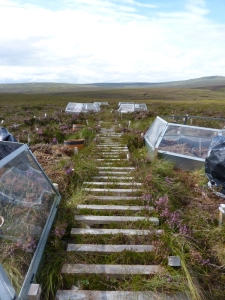A bright, blustery day in England’s north Pennines. Fluffy cotton grass heads bob and bounce on the breeze. On the side of a hill, a strange array of hexagonal, knee-high structures glint and sparkle. Four figures, hunched against the wind, move methodically along jaunty wooden boardwalks, which rest on the blanket bog, crouching at each hexagon in turn. Welcome to Moor House National Nature Reserve, the site of an experiment designed to investigate how a warmer climate will affect the speed with which plant litter is recycled back into the soil, and ultimately the atmosphere.

The resulting paper, in ESA Ecology, describes an experiment that uses a combination of open-top, passive warming chambers and plant removal treatments to investigate how the presence of certain plant functional types and warmer temperatures affect rates of litter decomposition. The authors used litter bags, filled with the litter of each plant functional type and buried in plots beneath the plant removal and warming treatments. In all, there were eight treatments (combinations of graminoid, shrub and bryophyte removal, a bare plot and a control with no plants removed), replicated over four blocks, with half the plots warmed by the passive chambers.
The main finding of the paper is that presence or absence of plant functional groups had a stronger effect on peatland litter decomposition than the warming of approximately 1°C achieved by the passive chambers. Removing the shrubs from the peatland resulted in faster decomposition of graminoid and bryophyte litter, after two years. Litter identity was also important – in the first year of the experiment this was the main factor controlling rates of litter decomposition, with bryophyte litter decomposing most slowly, followed by shrubs and graminoids. After two years, the live plants present in the plot (i.e. presence of shrubs) were more important than the litter identity. Warming affected the composition of the bacterial community, while the fungi responded more strongly to the presence of shrubs.
 While these results are compelling, they should be taken with caution, as the authors suggest: since the duration of the experiment was two years, further interesting effects resulting from the decomposition of shrub and bryophyte litter, which happens more slowly than in graminoids, might not have been captured. After four or five years, the decomposition of more recalcitrant litter could reveal more interesting effects. The same is true for the warming treatment: given a longer study period, the effect of 1°C warming on plant litter decomposition might become more important. It is, however, easy to write ‘more long-term experiments needed!’ while, in reality, the amount of effort required to maintain the plant removal treatments and warming chambers in the harsh upland environment of the Pennines represents a considerable hurdle. And one has to motivate one’s volunteers to see past the inherent absurdity of weeding a moorland!
While these results are compelling, they should be taken with caution, as the authors suggest: since the duration of the experiment was two years, further interesting effects resulting from the decomposition of shrub and bryophyte litter, which happens more slowly than in graminoids, might not have been captured. After four or five years, the decomposition of more recalcitrant litter could reveal more interesting effects. The same is true for the warming treatment: given a longer study period, the effect of 1°C warming on plant litter decomposition might become more important. It is, however, easy to write ‘more long-term experiments needed!’ while, in reality, the amount of effort required to maintain the plant removal treatments and warming chambers in the harsh upland environment of the Pennines represents a considerable hurdle. And one has to motivate one’s volunteers to see past the inherent absurdity of weeding a moorland!
Overall then, what’s the message? Dead or alive, whether you’re graminoid, shrub or bryophyte seems to exert much stronger control on litter decomposition rates in peatlands than temperature. While warming doesn’t have much of an effect on plant decomposition, it does affect the bacterial community in the peat, which might have important implications for graminoid decomposition, since bacteria are well-equipped to munch through labile substrates. Fungi respond when you take away the shrubs, which provide the more recalcitrant litter they’re specialised for dealing with, and might therefore moderate the response of the peatland carbon cycle to warming. Given a longer time period, more effects may emerge from this experiment.
I’m interested to know about the responses of decomposition processes in other ecosystems to warming and plant functional group removal. In grasslands, for instance, what happens when you increase the ambient temperature and remove the nitrogen fixers? Of course, these sorts of studies require a sufficiently long period to become stable and start producing results. In a time of apparently perpetually shrinking budgets, what’s next for long-term field experiments in ecology and biogeochemistry?
This is an edited version of a post I contributed to the BES Plants-Soils-Ecosystems journal club.